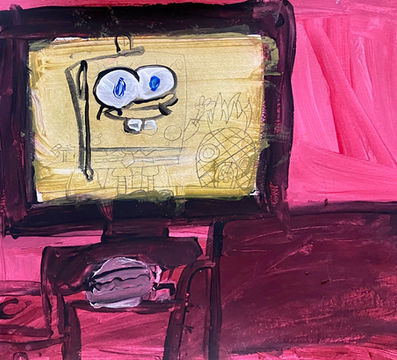
Emergency Exhibition:
New Training for Future Artists
and Art Lovers
Emergency Exhibition: New Training for Future Artists and Art Lovers brings together artwork by students aged Pre-K to 5th grade from Children’s Museum of the Arts’ three Emergency Arts Education Fund partner organizations across New York City: 1) Hudson Guild in Chelsea, Manhattan; 2) P396K Sid Miller Academy in Crown Heights, Brooklyn; and 3) Children’s Workshop School in East Village, Manhattan.
Although these three organizations are separated by geography, they have one thing in common — they have all lost arts funding as a result of citywide budget cuts. The works in this exhibition demonstrate the breadth of the experimental arts curriculum crafted and implemented by each of CMA’s Artists in Residence: Maria D. Rapicavoli at Hudson Guild; Niousha Kiarashi at P396K Sid Miller Academy, and Noormah Jamal at Children’s Workshop School. These three approaches vary in style, but are united in their goal to provide deeply ambitious free arts education to students who need it most.
The exhibition borrows its title from Mark Rothko’s 1934 essay New Training for Future Artists and Art Lovers, which encourages artists to approach their craft from the perspective of a child. For Rothko, the function of the instructor is to inspire confidence rather than impose overbearing guidelines. In this spirit, Emergency Exhibition: New Training for Future Artists and Art Lovers affirms the diversity of student learning profiles through a year of inclusive art instruction and joyful co-creation.
Hudson Guild
Chelsea, Manhattan
Children's Workshop School
East Village, Manhattan
P396K Sid Miller Academy
Crown Heights, Brooklyn
Look Make Show :
Arts Education Resources
Children's Museum of the Arts' free digital art resources provide educators with accessible arts education lessons that can be recreated in communities anywhere in the world using affordable materials. These child-centered resources are specifically aimed at those who have limited touchpoints to arts education, offering a blueprint for schools to revitalize or launch an arts education program – 100% free.
Collage & Photomontage
intro to Dada and surrealism
View & Download
Artists in Residence.
Maria D. Rapicavoli
CMA Artist in Residence 2023-24
Hudson Guild
Chelsea, Manhattan

Niousha Kiarashi
CMA Artist in Residence 2023-24
Sid Miller Academy
Crown Heights, Brooklyn
Noormah Jamal
CMA Artist in Residence 2023-24
Children's Workshop School
East Village, Manhattan
About Children's Museum of the Arts
Children's Museum of the Arts (CMA) is on a mission to unite children and artists to create and share ambitious works of art with their communities and the world. Since 1988, CMA has crafted innovative programs that change the way New Yorkers value its youngest artists and their aesthetic contributions. Our programs are 100% free and designed to inspire cultural change — by publicly celebrating what's possible when you give children the materials, access, and encouragement they deserve to be recognized and appreciated as real artists.
View exclusive exhibition content, including educator reflections, studio tours, and classroom visits on Bloomberg Connects, the free arts & culture app.

Programs at Children's Museum of the Arts are supported, in part, by public funds from the New York City Department of Cultural Affairs in partnership with the City Council and by the New York State Council on the Arts with the support of the Office of the Governor and the New York State Legislature. Additional support for this program is provided by Cornelia T. Bailey Foundation, LeRoy Neiman and Janet Byrne Neiman Foundation, William Talbott Hillman Foundation, Horace W. Goldsmith Foundation, and Wilhelm Family Foundation.

























































































































